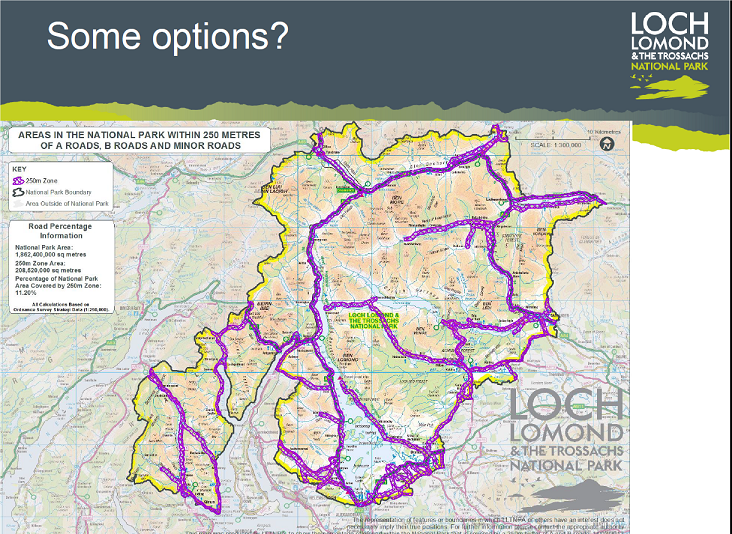
In early December the Park released to me slides which were presented at secret Board “Briefing Sessions” held on 6th September (see here) and 28th October 2013 (see here). These provide further evidence for how the Park developed its fatally flawed camping byelaws were developed and should be studied by everyone who cares or is involved in access rights in Scotland. The slides are an education in how not to approach access issues.
Before considering the slides from these two meetings, its worth considering why it has taken the Park over a year to make them public since I first asked for all written information about the Board’s involvement in the development of the byelaw proposals. First, the Park failed to tell me about these two meetings when I first asked for a list of all meetings which had considered the Your Park proposals. The Park’s subsequent excuse for this was that I had asked for information relating to the Your Park proposals and it was only after these meetings that the Your Park terminology – parkspeak – was developed! You only need to take one look at the slides to realise the Park was wanting to ban camping from September 2013. Second, while after the LLTNPA had released a list of all topics discussed at secret Board “Briefing Sessions” since 2010 (see here), it was clear these two meetings had considered camping, staff claimed they held no written infomation pertaining to these meetings. I challenged this in November, after evidence emerged that the Park had withheld information from the Information Commissioner (more on this in due course when the Commissioner has finished their investigations), and, low and behold, the LLTNPA suddenly found it did have written information on these two meetings after all! I am still not convinced they have released all of it – Page 11 of Appendix A for example is a blank slide – and have written to the Park asking them to explain anomalies. What all of this shows is that the LLTNPA’s claim to operate in an open and transparent manner is complete rubbish. I believe there there needs to be a systematic external review of how the LLTNPA operates and how it has subverted basic principles of good governance.
Back to the slides………………..!
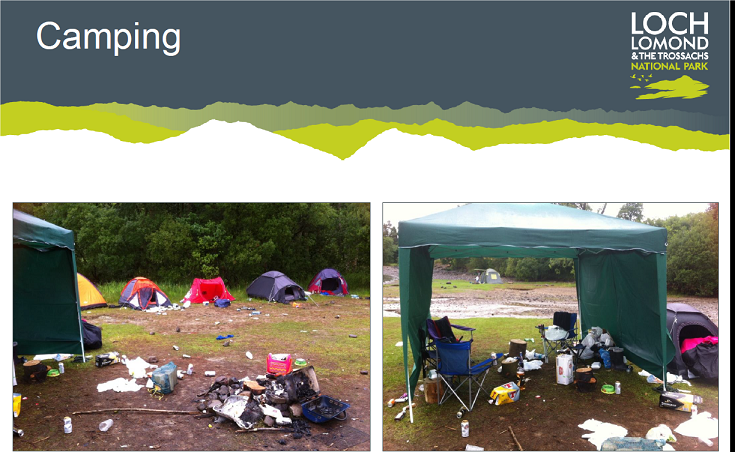
This was the second slide presented to the Board on “Camping Management – new approaches”. Shocked, so you might be, but most campers do not behave anything like this. Abandoned tents, as the latest Keep Scotland Beautiful Litter Audit shows (see here), are a rare occurrence compared to the total numbers camping. My best estimate from this data, and its the best estimate there is given the Park has never made any attempt to assess this, is that tents are abandoned in c1% of camping trips. And in most cases of abandoned tents the mess is not anything like what is pictured. What is important about this slide therefore is that senior Park staff set the Board off on the wrong course, they presented the litter problem as being inextricably linked to campers. The slide was a complete misrepresentation of the truth. The Board appear to have been convinced ever since that if only they can manage camping all the Park’s litter problems would disappear. This was the wrong starting point. The result has been the LLTNPA Board, in all its secret Briefing Sessions FOI 2015-021 Response Appendix A – meetings that discussed ban, has never considered the numbers of responsible campers and campervaners or their rights. There is nothing either in any of the slides presented to the Board in all the Briefing Sessions that took place that shows they ever considered the framework for access rights agreed by the Scottish Parliament (e.g. the role of the Scottish Outdoor Access Code and the existing criminal law) and how this could be applied to visitor management in the National Park. That should have been the starting point for any discussion. Having started in the wrong place, the Board have been on the wrong course ever since.

This slide contains far more useful information than anything that was presented in the Your Park consultation. I thought it strange that the Park had never presented an analysis of the data it held for the Your Park consultation and that I had to obtain the Ranger Patrol records (on which this map must have been based) through a Freedom of Information request. Those records disproved many of the Park’s claims. What this slide shows is that the Park had actually conducted an analysis of the data it held but then appears to have decided to suppress that information. I think there were three reasons for doing this. First, the slide undermines the Park’s claims, which continue to be parroted by the LLTNPA Chief Executive Gordon Watson, that the byelaws were needed because of the sheer number of campers. The slide show that there were relatively few areas where camping was high. Second, if you compare this slide with 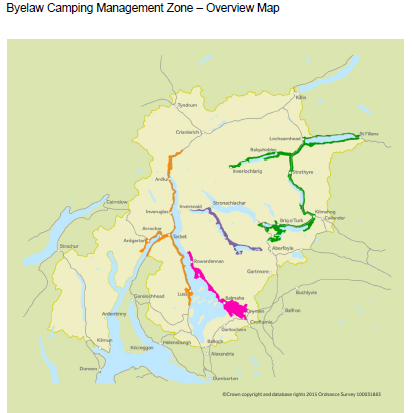 the camping management zones approved by the Scottish Government (left) it shows graphically that the actual camping management zones cover many areas where there is very little camping. The reason for this is explained by the slide at the top of this post on Options – the intention of the Park has always been to stop roadside camping and campervaning whether or not there was any evidence of problems or alternative solutions. That I believe remains the LLTNPA’s ultimate aim which is why the current byelaws encompass as many roads as the LLTNPA thought they could get away with. Third, the slide shows that the LLTNPA has always known the Loch Lomond Islands were one of the most popular areas for camping – and therefore under its own warped understanding that equates numbers with pressure – should have been a priority for it to tackle. It knew though that if the walking community and the boating community joined forces, it would lose the argument for byelaws, so it decided to introduce byelaws in stages. The LLTNPA Board Minutes from April 2015 record that the islands will be next. More evidence of how manipulative this National Park Authority is.
the camping management zones approved by the Scottish Government (left) it shows graphically that the actual camping management zones cover many areas where there is very little camping. The reason for this is explained by the slide at the top of this post on Options – the intention of the Park has always been to stop roadside camping and campervaning whether or not there was any evidence of problems or alternative solutions. That I believe remains the LLTNPA’s ultimate aim which is why the current byelaws encompass as many roads as the LLTNPA thought they could get away with. Third, the slide shows that the LLTNPA has always known the Loch Lomond Islands were one of the most popular areas for camping – and therefore under its own warped understanding that equates numbers with pressure – should have been a priority for it to tackle. It knew though that if the walking community and the boating community joined forces, it would lose the argument for byelaws, so it decided to introduce byelaws in stages. The LLTNPA Board Minutes from April 2015 record that the islands will be next. More evidence of how manipulative this National Park Authority is.
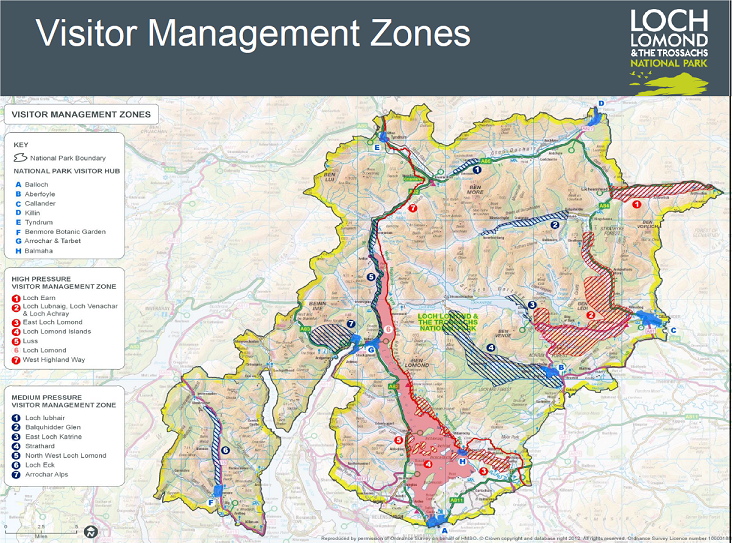
This slide shows that in their first debates there was some attempt by the LLTNPA to put camping into the wider context of visitor pressures. This should have been the starting point for a discussion on how best to allocate resources for visitor management as a whole, not just camping, but footpaths (Arrochar Hills and West Highland Way), litter facilities, parking places etc. Unfortunately, and we don’t know why, the LLTNPA quickly abandoned any attempt to look at visitor management in the round and focussed purely on camping.
 This slide clearly shows the LLTNPA were considering byelaws from September 2013 as the main solution to visitor management. Yet the public paper on Visitor Management presented to the Board Meeting of December 2013 gave almost no indication of this – it talked of a broad range of measures – while LLTNPA staff, when they met recreational organisations in late summer 2014, never made any reference to byelaws and were still claiming a broad sweep of management proposals. The Park therefore spent almost a year preparing to consult on its plan to introduce camping byelaws while deliberately keeping the recreational organisations – including its own Local Access Forum, a statutory consultee – and the wider public in the dark.
This slide clearly shows the LLTNPA were considering byelaws from September 2013 as the main solution to visitor management. Yet the public paper on Visitor Management presented to the Board Meeting of December 2013 gave almost no indication of this – it talked of a broad range of measures – while LLTNPA staff, when they met recreational organisations in late summer 2014, never made any reference to byelaws and were still claiming a broad sweep of management proposals. The Park therefore spent almost a year preparing to consult on its plan to introduce camping byelaws while deliberately keeping the recreational organisations – including its own Local Access Forum, a statutory consultee – and the wider public in the dark.
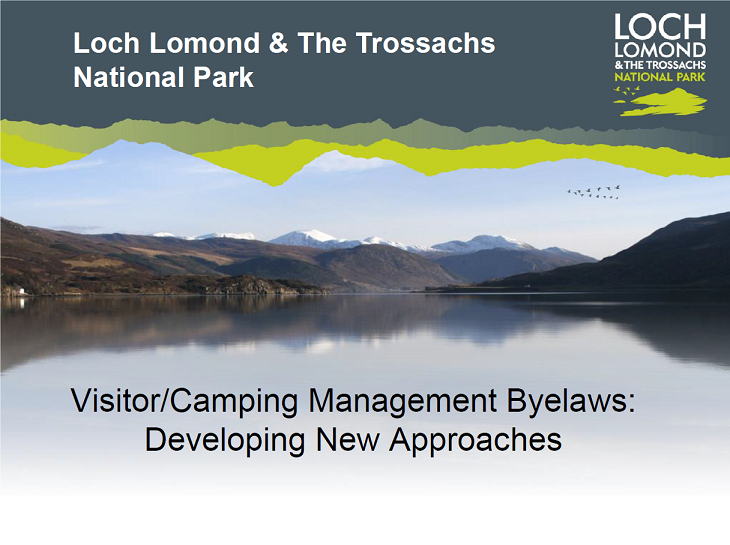
The title slide for the secret Board “Briefing Session” in October 2014 is interesting because it shows while the focus of the Board was on camping management, they were considering byelaws that could be applied to all visitors, not just campers. This potentially could have resulted in an even more drastic curtailment of access rights. I think this arose from the LLTNPA submission to the Land Reform Review Group where they had proposed the introduction of Fixed Penalty Notices for any breaches of the Scottish Outdoor Access Code, a draconian measure which had been rejected by the Scottish Parliament as being unworkable.

This slide provide further evidence that the second meeting did at least consider camping within a wider context before deciding to focus simply on camping. It also shows that the LLTNPA had done work on campervans at an early stage and clearly knew the numbers – note the symbols for carvan/motorhome pressures – which makes its current failure to provide for campervans even more telling (just 20 places across all the management zones (see here).

This shows is that right from the start the Park was considering how it could enforce a ban on camping and campervans before there had been any public debate on whether this was an appropriate way forward.
 This slide shows that the Park had from an early stage anticipated many of the objections that would be made during the Your Park consultation process. Instead of engaging on these issues, which might have resulted in alternatives solutions (e.g fishing permits could have been used to reduce the impacts from fishermen camping), the Park decided to go ahead with its own preferred solution – to ban camping – which it settled on in a remarkably short period of time. All the subsequent “consultation” was focussed on “persuading” people and organisations to agree with its own point view.
This slide shows that the Park had from an early stage anticipated many of the objections that would be made during the Your Park consultation process. Instead of engaging on these issues, which might have resulted in alternatives solutions (e.g fishing permits could have been used to reduce the impacts from fishermen camping), the Park decided to go ahead with its own preferred solution – to ban camping – which it settled on in a remarkably short period of time. All the subsequent “consultation” was focussed on “persuading” people and organisations to agree with its own point view.

This slide provides more evidence of how the LLTNPA had decided what it wanted to happen right from the start and mapped out the process by which camping and campervanning would be banned. While the process has taken two years longer than planned, the important point is that the Park had decided what to do and how before this was considered by any public Board Meeting. This is not how National Parks or any public bodies are meant to operate. Decision making is supposed to be in public, in fact my understanding this is a legal requirement. It clearly wasn’t observed and is another reason why the Scottish Government should reject the byelaws. By approving them the former Minister, Aileen Mcleod, in effect undermined basic standards of good governance in public authorities. Its not something her successor, Roseanna Cunningham, should accept.

Another Victor Meldrue piece of gobshite writing. My family, my daughters family and several thousands of families have returned to east lochlomond as a result of the improvements generated by the east Loch Lomond bylaws.
If you fell so strongly put your money where your mouth is. Start a petition and if you get more than 50% of the residents and 20% of the visitors agreeing with you then I will take notice. Alternatively take the lltnpa to court and get an injunction against their byelaws. Alternatively be real and shut up because only a very very small minority think you are marginally correct
John, I support your right to free speech and have no intention of “shutting up”. While we could debate the extent of the improvements on east Loch Lomond, I’d be interested to know why you believe such improvements as have taken place result from banning campers rather than the alcohol byelaws, the creation of the clearway which has made east Loch Lomond far less accessible, the blocking off of off-road parking eg at Lochan Maol Dhinne car park a mile or so North of Sallochy which had one of the worst records of environmental damage and was the scene for illegal partying or the targetted police action which took place at the time? The Review of the east Loch Lomond byelaws contained no analysis of the contributions of each of these factors nor did it provide (strangely) any analysis of visitor numbers – I would therefore be interested to hear the basis for your assertion that several thousands of families have returned to east Loch Lomond. Nick Kempe
Who is John Anderson? I have not heard of him. Acts like he owns the place.